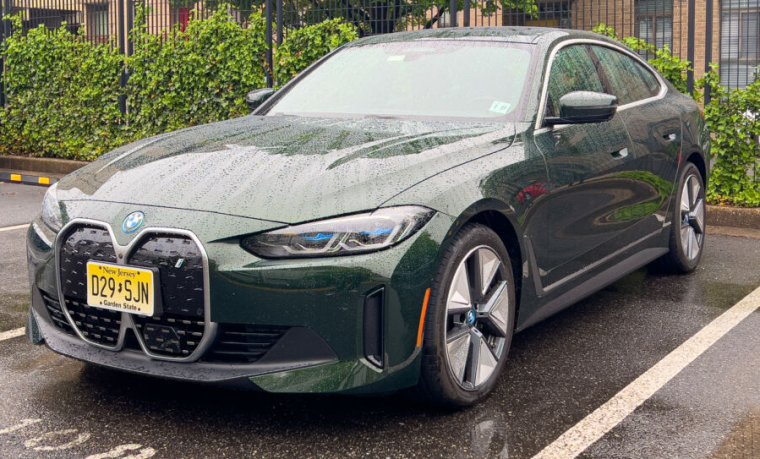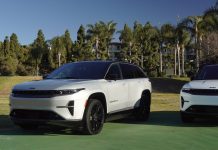This rear-wheel drive EV is efficient, practical, and has class-leading technology.

I have a theory about electric vehicles, and with a few notable exceptions, it’s this: The cheaper, less powerful version is usually the one to get. Big power outputs and short 0–60 times have been the industry’s go-to, but always with the trade-off being less range and a bigger sticker price. Today’s EV is a good example. It’s the BMW i4 eDrive40, a single-motor version of BMW’s smaller electric fastback sedan. It has taken a while to get some seat time in one, but the wait was worth it, because this is one of the best electric sedans we’ve tested so far.
I’ve driven the BMW i4 a few times now since its launch in 2021, but always the very fast, very powerful, rather expensive i4 M50. Which is fine, but not exciting like the M3. The i4 eDrive40 undercuts the twin-motor, all-wheel drive M50 by more than $10,000—it starts at a more reasonable $57,300 and goes more than 30 miles (48 km) farther on a single charge of the same capacity 84.3 kWh (net) battery pack, with an EPA range of 301 miles (484 km).
BMW made its name on the back of a string of driver-focused, rear-wheel drive sedans, and I had high expectations for the eDrive40 to live up to. With no front motor, there’s less weight on the front axle, and the front wheels just have to worry about steering and braking, not laying down power as well. Less power to put down means smaller wheels, which translates into a better ride and more range, although our test car was equipped with 19-inch wheels (a $600 option), which reduced its range to 283 miles (455 km) compared to the 18-inch option.
ADVERTISINGAdvertisement

Open the door via the aero-optimized recessed handle and things look promising as you slip down into the tan-colored seat. The steering wheel’s rim is thinner than you’d find in most modern BMWs, and its multifunction controls are proper buttons. Otherwise, the ergonomics are the same as the more speedy version, with a large double-screen display that stretches across from the A pillar to the center stack running BMW iDrive 8.5. This might be the last version of iDrive to still offer a physical scroll wheel as an input option alongside touchscreens and voice commands, so enjoy it while it lasts.
BMW builds good electric powertrains
At maximum output, the i4’s electrically excited motor can send up to 335 hp (250 kW) and 317 lb-ft (430 Nm) to the rear wheels. And in Sport mode, the first inch of throttle pedal travel delivers more than enough of that torque to jolt your passengers’ heads back into their headrests. Zero to 60 mph (98 km/h) takes 5.5 seconds, which might not sound like much in a 21st-century game of Top Trumps, but it’s more than enough for the real world.
Truth be told, I spent most of my time driving the i4 in Eco Pro, which dials back the power delivery even more than Comfort mode. Still, it never felt slow on the roads in and around Washington, DC. With the transmission set to B, there was a strong one-pedal driving effect; in D, lifting the throttle leaves the car free to coast, only regenerating (up to 116 kW) when you use the brake pedal.Advertisement
I prefer D for highway driving, as any kind of downhill gradient, however slight, equals a chance to glide along, often gaining a little speed for free in the process. (This is one benefit of an electrically excited motor, which creates no drag on the drivetrain when not energized; the other main benefit is no use of rare-earth materials in the motor construction.)

Indeed, 4.1 miles/kWh (15.2 kWh/100 km) was possible without much effort, and over the course of about 2,000 miles (3,200 km) and who knows how many journalists, this particular car had averaged 3.7 miles/kWh (16.8 kWh/100 km). But then, this is BMW’s fifth-generation electric powertrain, so it’s had plenty of time to learn how to make them efficient.
BMW quotes a DC fast-charging time of as little as 31 minutes from 10–80 percent, with charge rates as high as 200 kW. If you set a DC fast charger as your location in the built-in Navigation, the car should precondition the battery pack for optimum fast charging, but there’s also a way to turn that on manually in iDrive.
In practice, I arrived at the charger with 24 percent state of charge and saw a peak of 186 kW shortly after plugging in. As EV drivers will know, charge curves are definitely not linear, particularly past 80 percent SoC, and getting all the way to 88 percent—55.8 kWh in total—took 1 hour and 2 minutes. (Since that was spent enjoying brunch at Mama Chang, conveniently located next to a bank of Electrify America chargers, it was time well spent.) BMW says an AC charge from 0–100 percent SoC takes 8:15 at 11 kW.
ARS VIDEO
How Lighting Design In The Callisto Protocol Elevates The Horror
It feels appropriately luxurious for the price
The i4 comes with a decent amount of standard equipment, including LED headlights, Active Driving Assistant (BMW’s name for its suite of advanced driver assistance systems), and yes, Android Auto and Apple CarPlay. In addition to our test car’s San Remo Green Metallic paint ($650), the box had also been ticked for the Premium package ($1,900), which added heated front seats (you can heat the rear seats as well for an additional $350), a heated steering wheel, a heads-up display, wireless charging for your phone, more lumbar support from the seats, and different sounds for the drive modes.
Parking cameras with 360-degree surround view are part of a $700 Parking Assistance pack, and our car was also specced with the Driving Assistance Pro pack ($1,700) that upgrades the adaptive cruise control and lane keeping to BMW’s most capable system. There’s a gaze-tracking driver monitoring system, and on pre-mapped divided lane highways, the system will allow a driver to go hands-free as long as it can see they’re watching the road ahead. I prefer to do my own steering most of the time, but the enhanced Traffic Jam Assistant came in quite helpful more than once on some of Northern Virginia’s more congested highways.
- Most of us have had time to get used to the i4’s snout. A front license plate definitely helps.
- I have been seeing quite a lot of i4s on the road in and around DC, and I find it a handsome shape. Jonathan Gitlin
- The rain is about 50 percent pollen by volume in May. Jonathan Gitlin
- The traffic jam assistant was quite helpful. Jonathan Gitlin
- Yes, a BMW 3 Series from 20 years ago was smaller, but it also didn’t offer this kind of room in the back for adult passengers. However, the i4’s fastback shape does impinge on rear headroom somewhat. Jonathan Gitlin
- The trouble about being efficient at going to Costco is that even if you get there early enough to plug into one of the chargers, you’re rarely in the store long enough to add more than three or four miles of extra range. Jonathan Gitlin
- I would never use the automatic parking feature, but I probably would pay for it because it’s the only way to get 360-degree cameras, and I love that feature a lot in modern cars. Jonathan Gitlin

Although BMW no longer offers a station wagon variant of the 3 Series, the i4 is the next-best thing, as it’s really a five-door fastback, not a four-door sedan with a trunk. The raked rear screen means you can’t load it quite as full as a 3 Series Touring might allow, but with the rear seats folded flat, the cargo volume increases from 10 cubic feet (238 L) to 45.6 cubic feet (1,291 L), and the large opening means it should be easy to get something like a mountain bike or surfboard in there with ease. The rear seat is split 40:20:40, so you have some flexibility to still carry a passenger in the back while boosting your cargo capacity.
In all, my high expectations for the i4 eDrive40 were met with aplomb. Just about the only thing I find to really criticize is a lack of visibility out of the rear, particularly if the back seat headrests are in their raised position. Now, my only real unanswered question is if the even cheaper, even less powerful $52,200 i4 eDrive35 (which uses a smaller battery and so offers less range) is also as sweet. The i4 is more expensive than a fully loaded Hyundai Ioniq 6—my other go-to suggestion for an electric sedan—but it’s also more luxurious and more engaging to drive.
If you’re looking for a reasonably sized EV sedan with class-leading technology and darn good efficiency from an automaker that knows how to build a good driver’s car, the i4 would be my pick.




